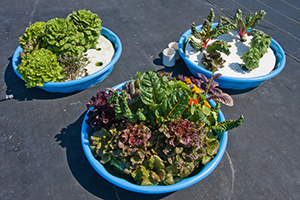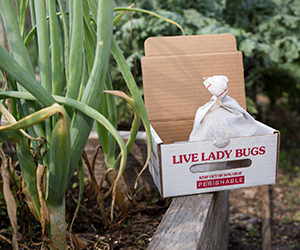The Quick Start Guide to Home Vegetable Gardening

Florida's summer temperatures can be too hot even for many warm season veggies, like eggplant, peppers, and cucumbers. Check your region's gardening calendar for optimal planting dates! UF/IFAS
Starting a vegetable garden is exciting! It is also a significant investment of time, energy, and resources. The intent of this guide is to guide you all the way from planning to harvest. Your garden should reflect your goals, resources, and values. Because these are different for each person, each home garden will be different.
Whatever your goals are, this quick-start guide can help you achieve them. You can follow the steps below to reason through the choices you'll need to make before you start. By walking through the process in advance you can avoid some gardening problems altogether.
Ask yourself the questions at each step to help you plan. Follow the links for more information. (Links that take you to websites besides Gardening Solutions will open in a new window.)
Step 1: Determine your goals for your garden
Starting with a clear goal in mind. This will keep your gardening a labor of love rather than a burden. What are you hoping your garden will provide? Is it fresh produce and food security? Savings on your grocery bill? A learning experience, or maybe entertainment? Consider your reasons and then move on to the questions below.
- Will you feed yourself and/or family? Check your local laws and policies before you begin a garden.
- Are you hoping to grow some young gardeners, too? Consider garden activities for children.
- Will you feed others? And make a profit? Businesses should consult the Florida Direct Marketing Guide, from the UF/IFAS Bookstore.
Step 2: Consider your resources and limiting factors
There is a way to garden in every space, but not all methods are appropriate for all spaces. A successful garden is one that takes your resources and limitations into account.

Small container gardens can be productive and beautiful for growing some of your own food. UF/IFAS
- How much experience do you have? If you're new to gardening, you may want to start small. Consider beginning with square foot gardening.
- How much time are you able to spend on this project? Consider:
- Purchasing materials and plants
- Building and filling the garden beds
- Frequent watering, weeding, and pest control
- How much space do you have? Here are some ideas for choosing a site and for gardening with limited space.
- Does that space receive enough light? Most vegetables require 8+ hours of direct sunlight per day.
- Does it get good airflow? If not, fungal disease issues could arise.
- Does it have easy access to a water source, drainage, and power?
- What nutrients are already in your soil? Do you plan to add soil?
- Here is some information on working with Florida's soils
- The UF/IFAS Analytical Services Laboratories can help you test your soil (pdf) and determine which nutrients, if any, are lacking.
- How much money are you able to spend on this project? Set a budget and consider:
- Soil and fertilizer
- Tools and building materials
- Seed and transplants
Step 3: Choose the type of garden best fits those resources and limitations

Passive hydroponic systems can be easy, affordable, and productive for growing greens in containers ranging from buckets to baby pools.
Begin by looking over the different types of gardens. Embrace your limitations! You can be successful with what you have to offer your garden.
- Are you apartment bound? Micro greens, tabletop hydroponic systems, or growing with artificial lights can be successful.
- Are you short on time? Research irrigation options, including self-watering and automated growing systems. You can also install micro irrigation on a timer.
- Are you on a tight budget? Check out these tips for planting a moneywise vegetable garden.
Step 4: Make a list of what you would like to grow
Get started with this list of vegetables for Florida gardens. Then narrow down your list by asking yourself the following questions.
- What vegetables do you already eat and enjoy? Read our article, Growing Your Groceries for tips on choosing what to plant.
- What month will you start your garden? Which vegetables can be planted that month? Check the Florida garden map to find your region. Then check your region's gardening calendar:
Step 5: Research the crops left on your list
Most information should be available on the vegetables for Florida list. If you still have questions, you can go into detail by searching your crops on the UF/IFAS Electronic Data Information Source (EDIS).
- What pest and disease issues are likely to occur? Consider choosing resistant cultivars. There's a list of suggested varieties in the Florida Vegetable Gardening Guide.
- What are the plant's nutrient requirements? Learn about fertilizers, when and how to fertilize, and about adding organic soil amendments.
- What zone is the cultivar recommended for? Reference the USDA Hardiness Zone Map to know your zone.
Step 6: Choose crops that fit your goals, resources, and type of garden
Consult with your county Extension Agent if you need help choosing your final crops and cultivars. They, and the Master Gardener Volunteers, are experts in gardening in your area.
Step 7: Design, plant, and maintain your garden
Here are some tips for laying out your vegetable garden, even in a small space.

Beneficial insects may help you control pests. Identification is key for knowing good bugs from bad bugs.
- Learn when to water
- Learn when to mulch
- Learn how to stay safe in the heat
- Learn how to practice Integrated Pest Management (IPM)
- Do you practice proper sanitation? Learn how to sanitize your garden tools and prevent the spread of disease.
- Can you tell the good bugs from the bad bugs? This website can help you identify pests.
- What will you do when you find a pest? Learn more about pesticides. Use beneficial insects and natural products when possible.
Step 8: Enjoy your harvest!
After all that hard work, the harvest is a welcome finish line. It's time to prepare delicious meals, and preserve your crops to enjoy throughout the year. But what will you do post-harvest to ensure food safety?
- How will you store your harvest? If you're unsure, here is a webinar on food safety.
- Here is some information on harvesting and storing vegetables:
Growing your own food is empowering and exciting. It may even provide a sense of security. Of course, gardening is challenging at times, and a harvest is never guaranteed. The best gardeners are probably those that have killed the most plants, but learned from it. Those gardeners embrace the lessons their gardens teach them season after season. Green thumbs are earned.
And remember, if vegetable gardening is just not your thing, that's okay. You can still support Florida agriculture by purchasing and requesting Florida-grown produce. Florida's farmers are working hard to feed your family. Check produce labels at the grocery store, go to the farmers market, venture out to local farms, and buy "Fresh From Florida!"
Sustainable Home Food Production Series
With renewed interest in growing produce at home, we've developed a series of articles, "Sustainable Home Food Production," to get you started.

